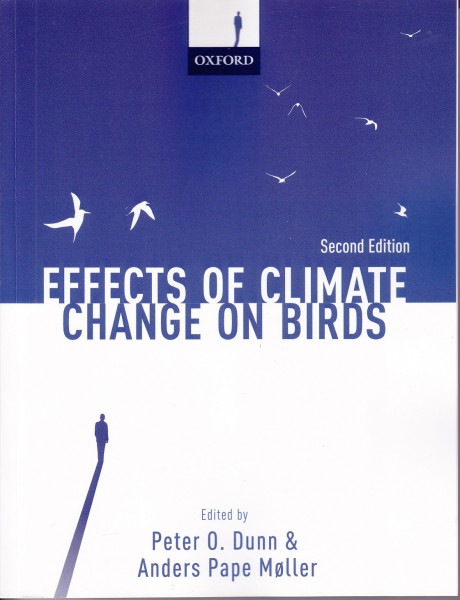
Publisher: Oxford University Press, Oxford
Publication Year: 2019
Binding: 1
Page Count: 288
ISBN Number: 9780198824275
Price: £37.99
Effects of Climate Change on Birds
Since the publication of the first edition of this edited volume 10 years ago, we have all grown in our awareness of the twin biodiversity and climate crises that the planet faces. There is building evidence that the climate is changing, and of its impact on biodiversity, of which the literature on birds is a significant component. The authors start their book with an assessment that more than 11,400 papers have been published on the subject of climate change and birds, of which two thirds have been published since 2010. This makes it very difficult for any of us to keep on top of what is a fast moving literature, and so Dunn and Møller have pulled together an impressive list of 35 internationally respected authors to write 19 chapters that provide an accessible way into this vast topic.
The chapters are split across four sections. The first introductory section contains a useful summary of climate change that is particularly helpful for anyone struggling with the complexity of the climate system and the breadth of impacts. It concludes with a bullet point summary of major IPCC results that provides a handy reference of the subject. Having this at the start of the book provides a useful platform on which the rest of the volume is built.
The second section has a methodological focus and includes five chapters that provide a useful summary of approaches and latest advances in relation to a number of key aspects of the subject. The first of these reviews sources and approaches to analysing long-term climate data. This will be particularly useful for anyone looking to access such data for their own studies, although there is a risk that the websites mentioned where data may be accessed may gradually go out of date. The second chapter nicely complements the first by reviewing different sources of bird data, many of which result from citizen science initiatives. Three more statistical chapters then follow that consider ways to quantify climate sensitivity, ecological niche modelling and the analysis of population dynamics. These excellent summaries should be very helpful for those looking to undertake similar analyses, and particularly describe some of the most recent developments in modelling impacts on populations.
Evidence around the impacts of climate change on bird populations forms the subject of the third book section. This contains chapters that review changes in migration, timing of breeding and breeding success, physiological responses, evolutionary responses, population responses and changes in distribution in response to climate change. The first four of these chapters nicely document the range of impacts observed - the chapter on physiology in particular contained much recent material that was new to me. The latter two chapters in this section are more methodological in nature, reviewing approaches used for future projections of abundance and distribution respectively. Like the chapters in section two, they do so with reference to much new and recent material, usefully highlighting challenges of scale and propagating uncertainty, but I did wonder if these chapters would really have fitted in better in that section. Given the title of the section on population consequences, I also felt that an overview of the evidence of the impacts of climate change on bird populations across the world would have made a useful addition.
The final section of the book, entitled interspecific effects of climate change, puts birds in a wider ecological context. Two of the chapters consider particular mechanisms of climate change impacts, covering host-parasite and predator-prey interactions, whilst a third also covers aspects of relationships with other taxa. Both the host-parasite and predator-prey chapters included some really nice recent examples, the first in my opinion being something of a neglected topic, whilst the latter provided a nice overview of what is now a really quite extensive literature. The next chapter is a succinct summary of the impacts of climate change on bird communities, summarising what is really some of the most compelling evidence of impacts to date. Finally in this section, an ambitious chapter gives a pretty comprehensive assessment of the attempts that have been made to assess the future vulnerability of birds to climate change, and considers how best conservationists should respond.
For anyone wanting to get up to speed with the topic, or even for those more familiar with the subject but struggling to keep up with the literature, I would heartily recommend this book. As a result of being an edited volume, it does suffer from a degree of duplication between some chapters whilst other aspects of the subject were hardly covered at all, but in general the chapters are excellent and in combination they provide a pretty comprehensive summary. I would have welcomed more of a synthesis from the book editors to pull out key themes and patterns across the chapters and sections. Their concluding chapter was pretty short and given their experience, felt like a lost opportunity to provide more of a challenging synthesis of the subject. Having said that, I would agree with the five main areas of future research need that they highlight, so do go and read this book, and be inspired to tackle at least one of these!
Book reviewed by James Pearce-Higgins
Buy this book




Share this page